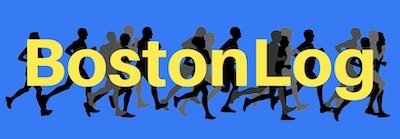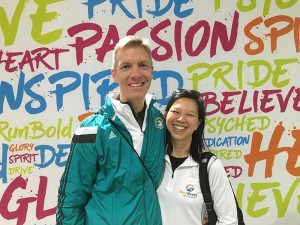The “Marathon” race from Ashland to this city, held under the auspices of the Boston athletic association yesterday… proved a great success and is an assurance of an annual fixture of the same kind.
– The Boston Globe, 20 April 1897
I’d made it to Mecca.
Not the Holy Land to which devout Muslims make their annual pilgrimage, but the one to which devout runners make theirs. I’d made it to Boston.
Ok, so technically that wasn’t true — not yet. As Katie’s childhood buddy Paul and I meandered through the Athletes’ Village awaiting the start of the world’s most prestigious marathon, the truth was I’d made it to Hopkinton, a town conveniently located 26.2 miles west of the finish line in Boston. Now that the hardest part — the months of high-mileage weeks, long training runs and marathon-pace workouts required to get here — was over, the long-anticipated last step in my journey to Boston Marathoner was about to begin.

But eager was just one of the raw emotions crackling like unseen currents of electricity through the Athletes’ Village — unseen yet unmistakable, like the metallic scent of ozone before an electrical storm. And all of us good conductors. Eager. Nervous. Cheerful. Stoic. Adrenalized. Ready. In some corners, a dash of nauseous and a smidgen of scared. Some runners chatted as they waited in line for the porta-potties; others splayed out on the shaded grass under the tents, conserving energy; still others sat absentmindedly reading the ingredients on their race-day packets of yummy GU.
Early to bed and early to rise makes a man healthy, wealthy, and first on the bus.
— Benjamin Franklin, philosopher, politician, and Boston Marathoner.
Katie’s and my iPhone alarms had chimed simultaneously at 5:45am, nearly two hours after I’d first bolted awake, my mind instantly alert to the fact it was Marathon Monday. Feeling cold, I’d realized I was drenched in sweat thanks to our hotel room’s faulty thermostat. Bad Omen #1 on a day when my hydration needed to be dialed in.
I’d dressed & packed quickly, donning the Goodwill hoodie & pants I’d brought in anticipation of a comfortably cool wait in Hopkinton. Unfortunately, the weather had other ideas, and like an excitable runner on the first downhill, it too had started too fast. By the time Paul and I debarked at the Athletes’ Village after the easy 45-minute bus ride from the Boston Common, sunny skies and temperatures in the mid-60s greeted us. Ideal weather for watching the Boston Marathon, not so much for running it. Coming from SoCal though, where I regularly train in 70+ degree temps, I wasn’t overly concerned. Maybe we’d still get lucky as in 2011, when an epic tailwind propelled Geoffrey Mutai of Kenya to a course record 2:03:02 and Ryan Hall to an American record 2:04:58.
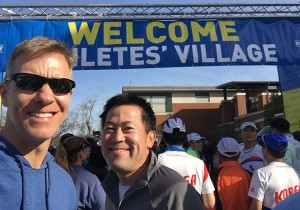
Though teeming with runners, the smartly laid-out Athletes’ Village offered plenty of elbow room compared with the crush & sensory overload of the pre-race expo, which was the most jam-packed expo I’ve ever attended (with Berlin a close second). Though conveniently located adjacent to the finish line on Boylston, the Hynes Convention Center is a smaller space than either McCormick Place in Chicago or the Javits Convention Center in New York. Definitely not a place for claustrophobics. Luckily, bib pickup was in a separate & much less crowded hall than the exhibitor booths, leaving each runner to decide whether and for how long they’d brave the expo itself.
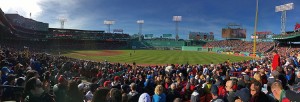
This year’s race would be unusual in its dearth of big names on the American side. Rather than competing at Boston, our country’s best marathoners had been at the Olympic trials eight weeks earlier, seeking to represent the U.S. at the Summer Olympics in Rio. For that reason, sightings of Meb, Shalane, Desi & Amy were limited to weekend expo appearances and — for those of us who’d planned ahead and snagged tickets — throwing out the first pitch before Saturday’s Red Sox game at Fenway Park.
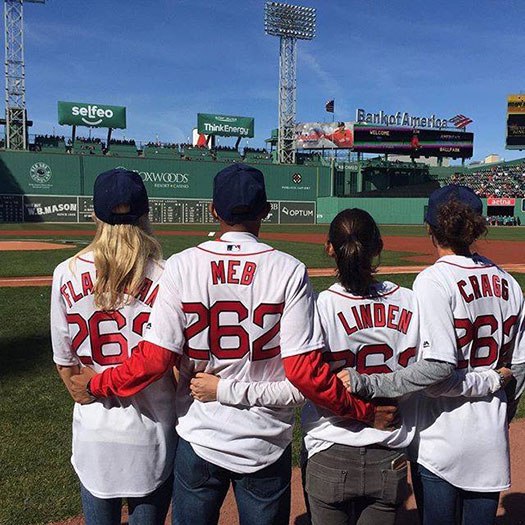
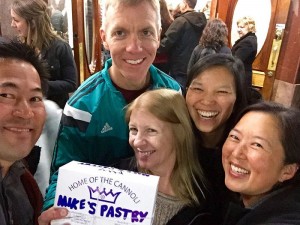
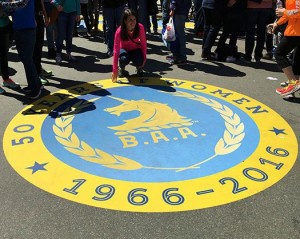 Adding to the festive atmosphere of the race, the BAA was celebrating the 50th anniversary of women running the Boston Marathon — five decades since Bobbi Gibb (this year’s Grand Marshal) made history in 1966 by banditing the race, six years before women were officially allowed to run. This year’s women’s winner, Atsede Baysa of Ethiopia, would later recognize this landmark occasion by presenting Gibb with her trophy after the race — a classy microcosm of the entire weekend.
Adding to the festive atmosphere of the race, the BAA was celebrating the 50th anniversary of women running the Boston Marathon — five decades since Bobbi Gibb (this year’s Grand Marshal) made history in 1966 by banditing the race, six years before women were officially allowed to run. This year’s women’s winner, Atsede Baysa of Ethiopia, would later recognize this landmark occasion by presenting Gibb with her trophy after the race — a classy microcosm of the entire weekend.
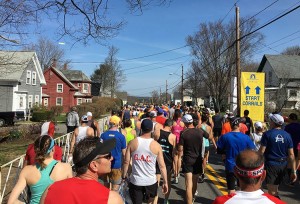
Showtime! The PA in the Athletes’ Village called on all runners in Wave 2 (our wave) to line up for the stroll to the start line. Dormant butterflies in uneasy stomachs fluttered to life. Our qualifying times — which this year needed to be 2 minutes, 28 seconds faster than the official BAA standards for acceptance — placed Paul and me squarely in Wave 2, though in different corrals. So after exchanging “good lucks,” we joined our respective corrals for the 0.7-mile trek to the start, me chatting all the while with a 3x Boston finisher from Cincinnati who’d qualified this time around at the Indy Monumental Marathon.
Volunteers were handing out cups of water near the start, and with the sun now high in the sky I was already sweating as I approached Corral 5. Bad Omen #2.
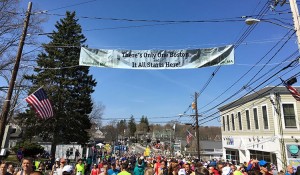
As I stretched my calves, I took a moment to reassess my time goals. On a warm day and on a rolling course like Boston which I’d never seen, much less run, sub-3:30 would be a jog well done. More than anything, though, I wanted to seize the day as much as possible — who knew if or when I’d make it back. Which was one reason I’d chosen to carry my iPhone to take pictures, the other reason being the handy Share My Run app I’d be using so Katie and my sister Sandy (in her first visit to Boston) could follow my progress in real-time.
Before my excitement had time to crescendo, the 120th running of the world’s oldest continuous marathon had begun. Carried inexorably across the start line in a parade of brightly clad bodies, I settled in with the other 27,486 runners bound for Boston, bracing myself for the opening salvo I’d heard so much about — the fast downhill out of Hopkinton.
Rarely do I Garmin-gaze like I did during those first three miles. Based on past experience and the warnings I’d heard all weekend, I was determined to stay in my shoes and not start too fast. I’d noted on a wristband my desired pace-per-mile — 7:54, 7:49, 7:25 — so when my Garmin chimed in with a 7:52 followed by a 7:49 followed by a 7:33, I was feeling good.
Except I wasn’t. By Mile 3 in Ashland, I could already tell my breathing was labored and my heart rate elevated — on a largely downhill stretch. And I’d yet to find the easy rhythm I typically fall into by mile 3. Too much of my attention was focused, not on the cheering spectators already lining both sides of the course, but on checking my pace and not stepping on/elbowing others in this 26.2-mile caravan. On the narrow suburban streets, running a straight line proved impossible as other runners frequently cut in front of me trying to find personal space or access the aid stations.
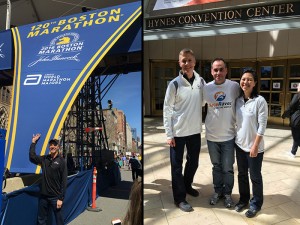
I have not yet begun to fight. — John Paul Jones, naval war hero and runner.
Despite my own issues, the locals lining the course did everything they could to v.erbally propel us forward, with their unflagging cheers and personal touches that make Boston the one-of-a-kind event it is. I heard no fewer than half a dozen cheers for RaceRaves (the shirt I was wearing) throughout the day, and though I neither saw nor met her I know I was running near Molly for the better part of a mile.
Several groups were clearly out to make a day of it, with smoke billowing from their grills and sprinklers set up to help cool overheated runners. Both kids and adults cheered while simultaneously bouncing on mini-trampolines. And the musical highlight of the course was Neil Diamond’s “Sweet Caroline” — embraced & adopted by Red Sox fans for their 8th-inning singalong — twice in the first seven miles, making me wonder just how many times we’d be hearing it in the span of 26.2. Luckily, twice would be enough.
Most of the course is distinctly and charmingly suburban New England. Granted, Hopkinton looks like Ashland looks like Framingham looks like Natick — but running Boston isn’t about the scenery, and I scarcely noticed the unchanging backdrop of white picket fences and calligraphic trees still in search of spring’s first kiss.
Somewhere along the way I caught up with the unmistakable duo of Team Hoyt. After Rick Hoyt was born with cerebral palsy, he and his father Dick began racing in 1977 and completed every Boston Marathon together — with Dick pushing Rick in his wheelchair the full 26.2 miles — until Dick hung up his racing shoes for good following the 2014 race. Team Hoyt member Bryan Lyons accepted the mantle from Dick and now continues the tradition of pushing Rick in his wheelchair. I applauded and cheered them on as I passed, feeling distinctly humbled to be running alongside such inspiring & beloved icons.
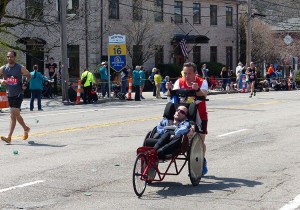
As my pace slowed gradually over the next several miles and I realized sub-3:30 would be an epic struggle, I exchanged more high-fives with spectators, including one tiny fellow whose dad called out a “Thank you” to me for my detour. Spectators, supporters and volunteers thanking me for running their marathon — this was a theme repeated all weekend and one that gave me goosebumps pretty much every time I heard it.
Tom Grilk, Executive Director of the Boston Athletic Association, said it best in the title of his 2014 TEDx talk — In Boston, everyone owns the marathon.
As I neared the 13.1-mile mark in Wellesley, I found myself solidly wishing I’d qualified for the Boston Half Marathon. Though I wasn’t hungry or thirsty, my breathing was ragged and my energy levels were fading fast. So Wellesley College couldn’t have come at a better time.
The Wellesley Scream Tunnel, which lines the right side of the course in Mile 13, is the hands-down highlight of the Boston Marathon. As vociferous as the rest of the course is, Wellesley makes the other 26 miles feel almost monastic. Donald Trump and Captain America could have been exchanging punches on the left side of the road and I doubt anyone would have noticed. Awesomely and profanely raucous, if anything could make you forget you’re running a marathon, it’s the women of Wellesley. Where else in the world can you ever get free kisses from strangers you might actually want to kiss??
I opted to stay left of the double-yellow line to soak up the scene and avoid any over-exuberant runners dive-bombing into the screaming throngs of coeds. I wasn’t disappointed — not only by the volume, but by the signage. Like Ulysses to the song of the Sirens, I nearly found myself drawn irresistibly to two signs that read “KISS ME I’M GAY” and “KISS ME OR I’LL VOTE FOR TRUMP.” Not to mention the handful of signs — “CHECK THAT ASS AS YOU PASS” may have been the tamest — suggesting that someone’s parents weren’t running this year’s marathon.
“BOSTON STRONG” and “RUN WICKED FAST” signs filled the rest of the course, complemented by the occasional other memorable sign like “DO EPIC SHIT” and “RUN! THE KENYANS ARE DRINKING YOUR BEER!”
These are the times that try men’s souls. — Thomas Paine, statesman and marathoner.
After Wellesley every mile became a struggle. So I was much relieved to reach Sandy, Katie and our friend Albion waiting at Mile 16 in Newton, at the bottom of the steep downhill that empties into Newton Lower Falls. There they waited less than ¼ mile from my Dad’s boyhood home. I checked in briefly, stretched my legs and pushed onward, warning Katie it would be a while before I rejoined them at the finish.
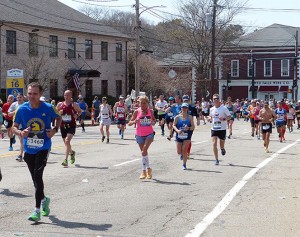
Even the psychological lift of counting down single-digit miles from 16 provided little (if any) physical boost. I wasn’t hungry, having eaten my usual meal before the race — plus I’d run plenty of 16+ mile training runs at marathon pace with minimal nutrition. I wasn’t thirsty, having made frequent use of the aid stations. And my quads & hip flexors weren’t hurting, still feeling strong without any apparent tightness. I simply had… no… energy. And a body that didn’t want to cooperate.
I tried to take solace in the fact that, since Boston doesn’t have pacers, at least I didn’t have to watch each successive pace group pass me.
Trying to draw inspiration from the tireless crowds, I shuffled up each of the four Newton Hills, which culminate at Mile 20 in the most infamous hill in all of road racing, Heartbreak Hill. An increasingly stiff headwind greeted us as we climbed, though luckily the mercury had progressively dipped since Hopkinton.
The Boston course includes only five turns along its entire 26.2 miles, and here we made the first of these, a sharp right turn by the firehouse in Mile 18 just before the second of the Newton Hills.
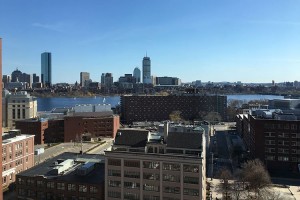
On any other day I would have been bent but not broken by this five-mile stretch, with four successive inclines of moderate but not intimidating steepness (most trail runners would scoff at the use of the term “hills” to describe them). Unfortunately, this wasn’t any other day. Even with the sheer wall of spectator noise pushing runners up Heartbreak, by the time I reached the Mile 21 marker, I was moving so slowly that the wheels were in danger of falling off if I didn’t take a walk break. And suddenly, the thought of running the Big Sur International Marathon (as part of the Boston 2 Big Sur Challenge) in six days left me queasy. One race at a time, one step at a time…
It was like an out-of-body experience, and I felt like a first-timer in this my 20th marathon. In fact, Boston was the first time since Crazy Horse 2011 — my second marathon — that I’d stopped to walk during a road race, that’s how bizarre this day was. I hadn’t even stopped to walk after twisting my ankle at mile 17 of the E.T. Full Moon Midnight Marathon. By the time I crested Heartbreak Hill, though, I had no choice. So for the next few miles, as the course followed a downhill-yet-still-rolling trajectory — past the screaming Eagles of Boston College, through Brookline and into Boston at last — I walked briefly at each mile marker, high-fiving spectators and regaining my momentum in short bursts.
Through all the misery of those last ten miles, I kept flexing the one set of muscles I could still control — I refused to stop smiling, even as I passed an increasing number of cramped-up runners trying desperately to stretch out their failing calves and locked-up quads. And was it just me, or was the number of medical tents increasing as well?
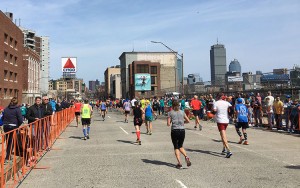
The finish is coming! The finish is coming! — Paul Revere, patriot and Boston Marathon finisher.
At Mile 25, with the beckoning Citgo sign now dominating the skyline and the roars from the onlookers intensifying, both mind & body sensed the finish line within reach. The “ONE MILE TO GO” marker painted on the ground in Kenmore Square provided one last shot of adrenaline, and I glanced up to see the familiar green outer walls and light towers of historic Fenway Park off to our right.
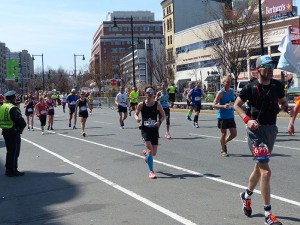
Even in my exhausted state, I recognized the moment when it arrived. I’ve never wanted a tattoo, but if I ever get one I know exactly what it will say — right on Hereford, left on Boylston. The final two directions every Boston runner hears, and the six celebrated words that tell you, I am this close to finishing the freaking Boston Marathon.
As I made the left turn onto Boylston, I glanced off to my right to see my buddy Neil from Minnesota, whose wife Jody had run a great race, cheering me on. I gave him a euphoric thumbs-up and turned my attention directly ahead of me, to the blue and gold pearly gates finish line arch 300 yards in the distance. Ironically, this home stretch was the only time all day when I legitimately wanted to slow down, and I took the time to bask in the moment and to soak up every last cheer from the thunderous walls of human sound urging us toward the finish. And I seriously would have high-fived every person on Boylston if I could have.
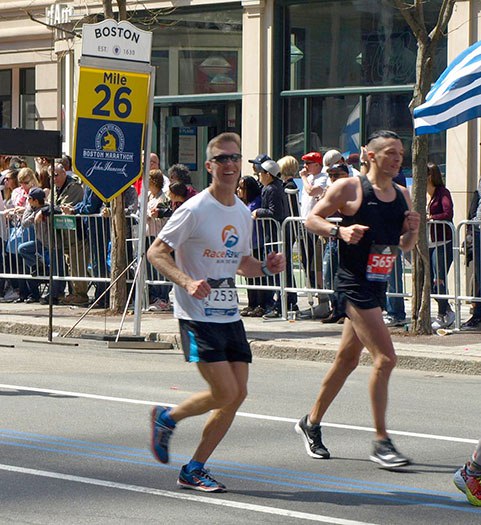
Eventually I ran out of room and had to cross the finish line into Copley Square, finishing my first Boston Marathon and my best worst marathon ever in 3:48:36. Even as competitive as I am, I can live with that result — because Boston (especially the first time) is all about the experience, and luckily I hadn’t set my sights on requalifying this year.
Clearly I still owe the course my best shot — though not immediately, as I’d like to step back and let the magic of this year’s experience sink in before I chase another BQ. And I have other racing goals to pursue in the meantime. But boy, it’s easy to understand how chasing (and re-chasing) the high of that qualifier year after year could easily become a full-fledged addiction. Heroin ain’t got nothin’ on the Boston Marathon.
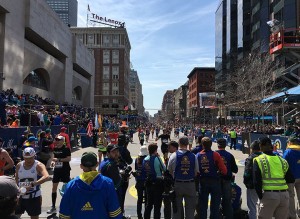
Turns out even the elite times were slower than usual, with no men breaking the 2:12 mark and only one woman cracking 2:30. And I heard more than a few horror stories of runners ending up in the medical tents with cramps or worse. Clearly I wasn’t the only one who’d misplaced my running mojo this year.
And yet I’m still puzzled by the fact my day went south so quickly, and with so little help from the course itself. I would say it’s something I need to figure out and correct pronto, but then again I may never know exactly what went wrong on Marathon Monday. After all the solid training, preparation, and tapering that preceded Boston, how could I have begun the day with an elevated heart rate? I have my suspicions — maybe filling every waking moment in the two days before the race wasn’t a great idea. Or maybe waking up in a cold sweat on race day was an even worse omen than I knew.
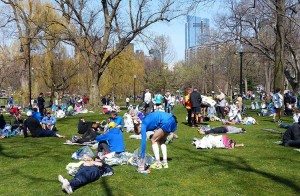
In any case, Boston reinforced the lesson I continue to learn time and time again: the marathon is the ultimate “tough love” teacher, and the lessons it teaches are humility, adaptability and don’t you dare give up-ity. Anyone can finish a race when they’re feeling good & running strong — but if you have a weakness the marathon will find it, exploit it and beat on it until you’re ready to throw in the towel. And then kick you in the gut a couple more times, just for good measure. It’s like a bully who turns you upside-down, shakes all the money out of your pockets and then takes your clothes just because, leaving you out in the middle of nowhere naked in the dead of winter. Laughing all the way.
As I shuffled triumphantly through the finish chute, Dad’s smiling voice — Boston born & bred — filled my head: Can’t do any bettah than that. And I could feel his hand on my shoulder, proudly confirming what my depleted body already knew and what I’d worked so hard to hear.
Post-race drinks are on me! — Samuel Adams, brewer and patriot.
Sheer exhaustion was probably all that prevented me from tearing up as yet another smiling BAA volunteer hung the coveted unicorn medal around my neck. I’d honestly never given much thought to the unicorn as the universally recognized symbol of the Boston Marathon, but it’s perfect — wild and ferocious, forever elusive yet endlessly pursued by man for its mythical power, beauty and ability to heal sickness.
Paul had run an excellent race (3:18:07), and he and his wife Jenny were already headed back to their hotel when I texted them, in between posing for the MarathonFoto minions. Reveling in the slow, deliberate stroll out of the finisher’s area, where volunteers continued to thank us for running Boston, I eventually reached the perimeter of the Boston Common where Sandy and Katie were waiting.
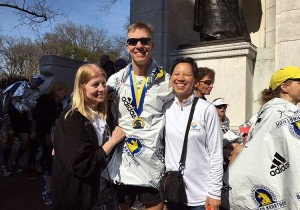
En route I was greeted by a group of four college-age fellows in Red Sox and Patriots gear, one of whom embraced me while another proclaimed loudly how totally awesome I was. Much as I would have loved to respond with a rapid & witty retort, all my fatigue & surprise would allow was a weak “No, YOU guys are awesome.” Anyone else, anywhere else, on any other day and I would’ve assumed I was the victim of a practical joke or hazing stunt. But on Marathon Monday in Copley Square, these guys were 100% sincere — and I was 200% appreciative.
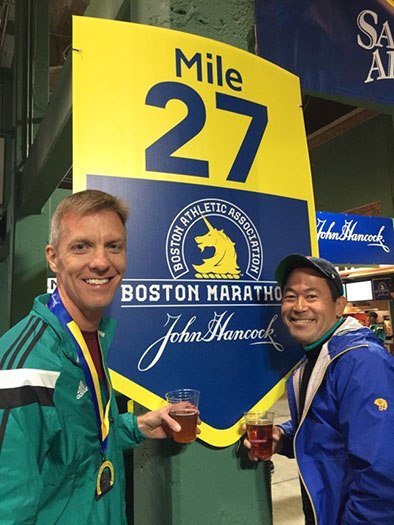
The post-race party that night at Fenway Park (sponsored by Samuel Adams, of course) was the perfect nightcap to a Patriots Day I wish I could bottle and share with every runner and non-runner I meet. Feeling down? Stressed? Overwhelmed? Overworked? Insecure? Crack open a bottle of Marathon Monday, breathe deeply and let one of life’s most amazing experiences wash away all negativity.
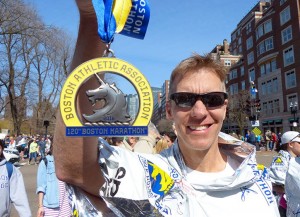 Hear the cheers. See the high-fives. Feel the gratitude. Everyone, from the most hardcore runner to the most sedentary bystander, coming together with a common purpose — to celebrate, support and inspire everyone else. A common humanity you have to feel & see to believe, shaped by 120 years of history and two bombs that showed the world — with all eyes watching — what it means to be Boston Strong. In this town, everyone takes this day to heart.
Hear the cheers. See the high-fives. Feel the gratitude. Everyone, from the most hardcore runner to the most sedentary bystander, coming together with a common purpose — to celebrate, support and inspire everyone else. A common humanity you have to feel & see to believe, shaped by 120 years of history and two bombs that showed the world — with all eyes watching — what it means to be Boston Strong. In this town, everyone takes this day to heart.
Because in Boston, everyone owns the marathon.
Mike Sohaskey
Marina Del Rey, California
Age – 45
Bib # 12539
3:48:36
In addition to his race report, Mike Sohaskey’s blog BlistersCrampsHeaves.com contains more photos, videos, and travel guide tips.
